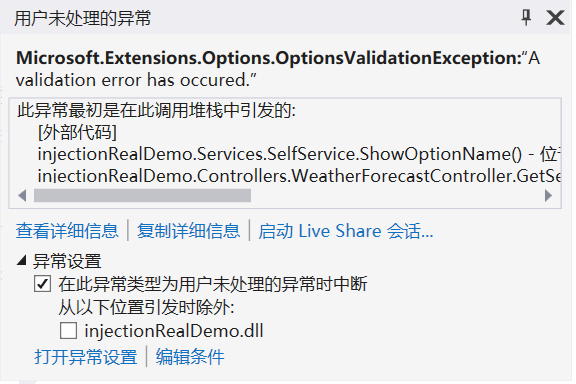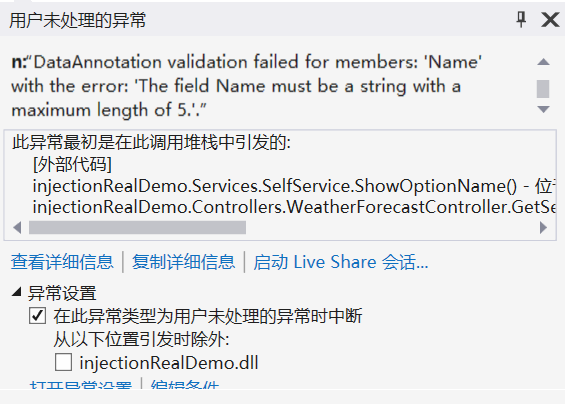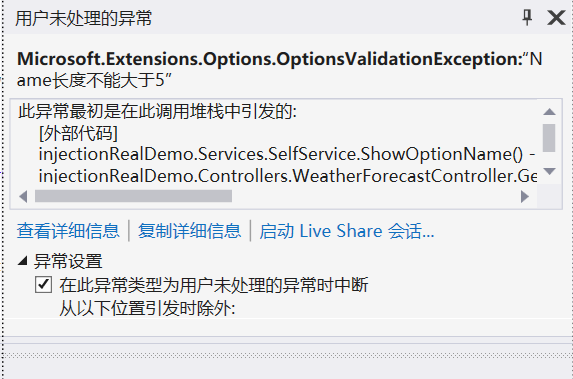前言
簡單整理一些配置的驗證。
正文
配置的驗證大概分為3類:
直接註冊驗證函式
實現IValidteOptions
使用Microsoft.Extensions.Options.DataAnnotations
直接註冊驗證函式
服務:
public class SelfService : ISelfService{IOptionsMonitor<SelfServiceOption> _options;public SelfService(IOptionsMonitor<SelfServiceOption> options){this._options = options;_options.OnChange((selftServiceOptions) =>{Console.WriteLine("alter change:" + selftServiceOptions.Name);});}public string ShowOptionName(){return _options.CurrentValue.Name;}}
註冊:
services.Configure<SelfServiceOption>(Configuration.GetSection("SelfService"), BinderOptions =>{BinderOptions.BindNonPublicProperties = true;});services.AddSingleton<ISelfService, SelfService>();services.AddOptions<SelfServiceOption>().Validate(options =>{return options.Name != "zhangsan";});
配置:
{"SelfService": {"name": "zhangsan"}}
測試:
[HttpGet]public int GetService([FromServices]ISelfService selfService){Console.WriteLine(selfService.ShowOptionName());return 1;}
結果:

使用Microsoft.Extensions.Options.DataAnnotations
services.AddOptions().ValidateDataAnnotations();
加上這個函式ValidateDataAnnotations。
然後我們的配置類上加一些屬性之類的:
public class SelfServiceOption{[Required][StringLength(5)]public string Name { get; set; }}
因為zhangsan 這個字元超過了5。
結果:

實現IValidteOptions
書寫驗證函式:
public class SelfServiceValidateOptions : IValidateOptions<SelfServiceOption>{public ValidateOptionsResult Validate(string name, SelfServiceOption options){if (options.Name.Length >5){return ValidateOptionsResult.Fail("Name長度不能大於5");}else{return ValidateOptionsResult.Success;}}}
註冊進去:
services.AddSingleton<IValidateOptions,SelfServiceValidateOptions>();
結果:

至於驗證的原理。
舉下面這個例子:
services.AddOptions<SelfServiceOption>().Validate(options =>{return options.Name != "zhangsan";});
檢視Validate:
public virtual OptionsBuilder<TOptions> Validate(Func<TOptions, bool> validation){return this.Validate(validation, "A validation error has occured.");}public virtual OptionsBuilder<TOptions> Validate(Func<TOptions, bool> validation,string failureMessage){if (validation == null)throw new ArgumentNullException(nameof (validation));this.Services.AddSingleton<IValidateOptions<TOptions>>((IValidateOptions<TOptions>) new ValidateOptions<TOptions>(this.Name, validation, failureMessage));return this;}
就十二中也介紹了,在OptionFactory Create的函式中:
//這是_validations的型別private readonly IEnumerable<IValidateOptions<TOptions>> _validations;//下面是Create 函式部分:if (_validations != null){var failures = new List<string>();foreach (var validate in _validations){var result = validate.Validate(name, options);if (result.Failed){failures.AddRange(result.Failures);}}if (failures.Count > 0){throw new OptionsValidationException(name, typeof(TOptions), failures);}}
會把我們的驗證全部驗證執行一遍,然後給出全部的錯誤,所以如果報錯的時候,應該把錯誤看齊,不是隻顯示一個錯誤,因為可能不止一個錯誤。
結
以上只是個人整理,如有錯誤,望請指點。
下一節,日誌系統之戰地記者